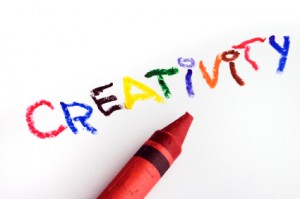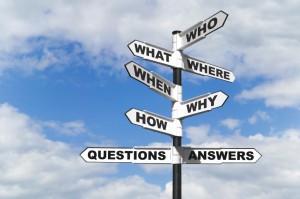Creativity Templates – 1
 I’m pretty good at leading brainstorming sessions. I can get people involved, gin up the excitement, and lead a rollicking session. They’re a lot of fun. But are they productive?
I’m pretty good at leading brainstorming sessions. I can get people involved, gin up the excitement, and lead a rollicking session. They’re a lot of fun. But are they productive?
Traditional brainstorming techniques derive from the concepts of free association and divergent thinking which, as Wikipedia notes, “… is a thought process used to generate creative ideas by exploring many possible solutions.” By exploring many different options, we may come up with something useful.
At the very least, it sounds inefficient – like the random programming of computers. Indeed, I rarely find useful ideas in traditional brainstorming sessions. A session may generate a lot of ideas but many of them of them are either trite or just plain silly.
So I was pleased to find a set of “creativity templates” in an article published in 1999 by Jacob Goldenburg, David Mazursky, and Sorin Solomon of the Jerusalem Scool of Business Administration.
The article investigates high quality advertisements. Do they have common features (templates) and can we use those commonalities to create better ads? The authors studied 200 award-winning ads and identified six basic templates (and several sub-templates). The researchers then compared the award-winning ads (let’s call it Group 1) to two other groups:
- Group 2 — 200 ads that had been selected for The One Show Album, a book of well-respected ads. Though selected for the album, these ads had not won other awards.
- Group 3 – 200 ads selected from the same publications and the same product categories as Groups 1 and 2, but that had not been selected for a collection and had not won awards.
Independent judges could classify 89% of the Group 1 ads into one of the six templates. Of the Group 2 ads, 50% used one of the templates. In Group 3, only 2.5% of the ads used one of the templates. So, the templates correlate to higher quality ads.
The researchers then tested whether their insights could be used to create new ads. They established three separate “creative teams” and asked each to create ads for fictional products. The teams were:
- Team 1 – “… was requested to generate ads based only on a brief (without additional training)…”
- Team 2 – received the same briefs as Team 1 but was also taught classic brainstorming techniques, including free association, before generating ads.
- Team 3 – also received the same briefs but was trained to use the creativity templates before generating ads.
Twenty participants were randomly assigned to the three teams and received the designated training. Each group then generated ads for several product categories.
The ads thus produced were then randomized and evaluated in a number of ways. The researchers recruited judges who did not know the objectives of the study and who used well-established criteria for advertising quality.
The findings were quite straightforward. “First, ‘template training’ was found to be superior to ‘no training’ and ‘free association” training and in all the comparisons pertaining to … ad quality measures. … In all cases, template training was superior to training in free association.”
Additionally, the research cast doubt on the efficacy of the free association method used by Team 2. “No clear indication was found that the free association method heightens creativity or brand attitude.” In other words, my frustration with brainstorming may well be justified – it doesn’t increase creativity.
So what are the six templates? We’ll get to that tomorrow. Stay tuned.
Are Creative People Weird?

Can’t you just focus?
I’ve always been proud of my ability to focus. In many situations, I can quickly distinguish between what’s relevant and what’s not. I can then block out irrelevant information and focus, for long periods of time, on what’s important. It’s a handy skill for a manager.
Like most skills, however, it comes at a price. First, it makes me a bit of an absent-minded professor. I may lose track of “irrelevant” details like anniversaries and birthdays. However, the more costly price may be a loss of creativity.
When I focus intently on something, I’m doing what a neuroscientist would call “cognitive inhibition.” In simple terms, I’m blocking out. I’m inhibiting information from entering my consciousness. I block out a lot of irrelevant stuff but I may also block out information that could lead to a creative solution.
We often think of creative people as being uninhibited. We use the term to describe their behavior rather than their thinking processes. They may dress unfashionably, behave eccentrically, write strident manifestos, and generally seem at odds with the mainstream culture. This is not a new phenomenon; Plato commented about the odd behavior of poets and playwrights.
We use the term uninhibited to describe behavior, but we should also apply it to thinking processes. In fact, a neuroscientist would call it “cognitive disinhibition”. Essentially, it means that we loosen the filters and allow a variety of thoughts to float to the surface. Fewer thoughts are inhibited or blocked out. Some people seem naturally to have fewer filters.
According to Shelley Carson in her article “The Unleashed Mind”, cognitive disinhibition is the basis of both eccentric behavior and of creativity. Carson defines cognitive disinhibiton as “…the failure to ignore information that is irrelevant to current goals or to survival.” Sometimes, this simply leads to bizarre thoughts and psychosis. For people with high IQs and large working memories, on the other hand, it can lead to creative eccentricity. Carson proposes a “shared vulnerability model” that underlies creativity, eccentricity, and high functioning “normal” performance.
The way we talk about creativity gives a clue to Carson’s model. When we have an “aha” moment, we often describe it as a “breakthrough”. We have literally broken through something – in this case, our cognitive inhibition. If we can lower the resistance to a breakthrough – by reducing our inhibitions – we can become more creative … and, perhaps, more eccentric.
Some moths ago, I wrote a brief article about sleep and creativity. We’re more creative when we’re sleepy. Carson’s model explains why: when we’re sleepy our cognitive inhibitions are lower. I’ve also written about caffeine and creativity. Caffeine keeps us focused. By doing so, it also reduces our creativity.
As it happens, I’m a huge consumer of caffeine. Perhaps that’s why I can focus intently on relevant information. Maybe it’s time to take a caffeine break to see if I can be more creative … and maybe a bit more eccentric.
Creativity and Caffeine

Gosh, I’m feeling so creative.
Last December I wrote a brief article asking, Are You More Creative When You’re Sleepy? The general idea is that you’re less likely to stick to nonproductive routines when you’re tired. Let’s assume that you know the “right” way to do something. When you’re fresh and energetic, you may repeat the process multiple times, even if it doesn’t work well. You’re more likely to assume that the process is correct but you’re making a mistake. Thus, you repeat the process, expecting to correct the mistake and achieve success. When you’re tired, you’re more likely to give up, and try something different — perhaps something more creative.
This week The New Yorker has an article looking at the same phenomenon from a different perspective. The question: does caffeine inhibit creativity? Caffeine tends to stimulate and focus the mind. If you’re more creative when you’re tired — because your mind wanders — then caffeine should reduce your creativity.
Maria Konnikova — who wrote Mastermind: How To Think Like Sherlock Holmes — wrote The New Yorker article and it’s well worth a read. Even if you’re not interested in creativity, you’ll be fascinated with the way Honoré de Balzac inhaled ground coffee dust because the brewed stuff just wasn’t strong enough.
Playing Up Creativity
 Want to be more creative? How do you get started? What are the best exercises to stimulate creativity? It all sounds very serious. As it turns out, it may not be so serious after all. The basis of creativity may simply be unstructured play.
Want to be more creative? How do you get started? What are the best exercises to stimulate creativity? It all sounds very serious. As it turns out, it may not be so serious after all. The basis of creativity may simply be unstructured play.
That’s the argument that the International Play Association (IPA) makes. According to the IPA white paper Children’s Right to Play, when children play, they “…rearrange their worlds to make them either less scary or less boring.” They also learn how to negotiate, the importance of rules, and a general notion of fairness. It’s not so much rehearsal for adult life (as I had thought). Rather, it’s “about creating a world in which … children are in control and can seek out uncertainty in order to triumph over it — or, if not, no matter, it is only a game.”
The IPA notes that unstructured play can enhance a child’s “…adaptive capabilities and resilience” and “changes the architecture of the brain, particularly in systems to do with emotion, motivation, and reward.” For all these reasons (and more), the IPA concludes that “… play is no mere indulgence; it is essential to children’s health and well-being.” (By the way, the IPA was established in 1961 in — where else? — Denmark. Those pesky Scandinavians again!)
Note that we’re talking unstructured play, which is different than, say, playing baseball or the piano. As Melinda Wenner points out in Scientific American, structured games “… have a priori rules — set up in advance and followed. Play, on the other hand, does not have a priori rules, so it affords more creative responses.” So, taking up all your kid’s time in sports leagues or music classes may actually impede rather than develop their creativity. It’s also important to let kids play with kids. Among other things, kids use more sophisticated language when they play with each other than when they play with adults.
That’s all well and good for kids but what about those of us who are well past our prime playing days? Wenner writes that “Adults who do not play may end up unhappy and exhausted without understanding exactly why.” How should adults play? Wenner makes three suggestions:
- Body play — “participate in some form of active movement that has no time pressures or expected outcomes (if you are exercising just to burn fat, that’s not play!)”
- Object play – create something with your hands
- Social play — “join other people in seemingly purposeless social activities, ‘from small talk to verbal jousting’…”
Wenner concludes that, “Ultimately, it’s not how you play but that you play.” So enough with this website. Let’s go out and play.
(By the way, IPA next triennial conference will be in Istanbul in 2014. Anyone want to go play?)
Computers Are Useless. They Only Give You Answers.
 I’ve worked with some highly creative people during my career. I’ve also worked with very insightful thinkers, both in business and in academia. Oftentimes, the two skills overlap: creative people are also insightful thinkers and vice-versa. I’ve often wondered if creativity leads to insight or if insight leads to creativity. Lately, I’ve been thinking that there’s a third factor that produces both — the ability to ask useful questions.
I’ve worked with some highly creative people during my career. I’ve also worked with very insightful thinkers, both in business and in academia. Oftentimes, the two skills overlap: creative people are also insightful thinkers and vice-versa. I’ve often wondered if creativity leads to insight or if insight leads to creativity. Lately, I’ve been thinking that there’s a third factor that produces both — the ability to ask useful questions.
Indeed, the title of today’s post is a quote from Pablo Picasso, who seemed both creative and insightful. His point — computers don’t help you ask questions … and questions are much more valuable than answers.
So, how do you ask good questions? Here are some tips from my experience augmented with suggestions by Shane Snow, Gary Lockwood, Penelope Trunk, and Peter Wood.
It’s not about you — too often, we ask long-winded questions designed to show our own knowledge and erudition. The point of asking a question is to gather information and insight. Be brief and don’t lead the witness.
You can contribute to a better answer — even if you ask a great question, you may not get a great answer. The response may wander both in time and logic, looping forward and backward. You can help the respondent by asking brief, clarifying questions. Don’t worry too much about interrupting; your respondent will likely appreciate your help.
Remember your who, what, where, when, how … and sometimes why — these words introduce open-ended questions that often result in more information and deeper insights. Be careful with why. Your respondent may become defensive.
Don’t go too narrow too soon — decision theory has a concept called premature commitment. We see a potential solution and start to pursue it while ignoring equally valid alternatives. It can happen in your questions as well. Start with broad questions to uncover all the alternatives. Then decide which one(s) to pursue.
Dumb questions are often the best — asking an (open-ended) question whose answer may seem obvious often uncovers unexpected insights. Even if you’re well versed in a subject, don’t assume you know the answer from the respondent’s perspective. He or she may have insights you know nothing about.
Be aware of your ambiguities — even simple, seemingly straightforward questions can be ambiguous. Your respondent may answer one question when you intended another. Here’s a simple example: what’s the tallest mountain in the world? There are two “correct” answers: Mt. Everest (if you measure from sea level) or Chimborazo (if you measure from the center of the earth). Which question is your respondent answering?
Think of parallel questions — I’m reading a Kinsey Millhone detective novel (U is for Undertow). One of the important questions Kinsey asks herself is, “why were the teenage boys burying a dog?” It gets her nowhere. But a slight tweak to the question — “Why were the boys burying a dog there?” — provides the insight that solves the mystery. (Reading detective novels is a good way to learn questioning techniques).
Clarify your terms — my sister is an entomologist. She knows that there’s a difference between a bug and an insect. I use the terms more or less interchangeably. If I ask her a question about bugs, she’ll answer it in the technical sense even though I mean it in the colloquial sense. We’re using the same word with two different meanings. It’s a good idea to ask, “When you talk about bugs, what do you mean?”
Think about how you answer questions — when you respond to questions, observe which ones are annoying and which ones lead to interesting insights. Stockpile the interesting ones for your own use.
Silence is golden — when speaking on the radio, I might say “over” to indicate that I’m finished speaking and it’s your turn. In normal conversation, we use body language and tone-of-voice to make the same transfer. Breaking the expected etiquette can lead to interesting insights. You ask a question. The respondent answers and turns it back to you. You remain silent. There’s an awkward pause and, often, the respondent continues the answer … in a less rehearsed and less controlled manner. Interesting tidbits may just spill out.
Don’t be too clever — Peter Wood probably says it best, “A few people have a gift for witty, memorable questions. You probably aren’t one of them. It doesn’t matter. A concise, clear question is an important contribution in its own right”.